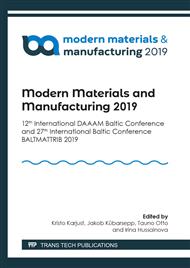p.52
p.59
p.65
p.71
p.77
p.83
p.89
p.97
p.103
Development of Testing Method for Assessment of Release Agent Effectiveness in High Temperature Forming Processes
Abstract:
Compaction of granular raw materials is a crucial process in modern heavy industries. Extreme operating conditions such as high temperatures, high loads and high press rotational velocities are applied in applications such as hot briquetting processes. For fast and smooth removal from the mold, the adhesion forces are a crucial parameter. To set up a model test for investigations of the adhesive behavior of several release agents under application-oriented harsh operating conditions an available forming tribometer was adapted. Special release agents to reduce adhesive wear and improve the release properties are considered. Surfaces and wear tracks of test samples were characterized by means of optical microscopy, 3D-topographical evaluation as well as SEM analysis. The benefit of the release agents on the subjacent microstructure was evaluated on cross-sections of tribo-stressed areas. Resulting adhesion forces could be well distinguished for all release agents and significant improvements to uncoated operating conditions were achieved. It was proven that the developed test instrumentation is suited to characterize the performance of release agents. The obtained results strongly indicate a significant decrease of severe surface deteriorations when suitable release agents are applied.
Info:
Periodical:
Pages:
77-82
Citation:
Online since:
April 2019
Authors:
Keywords:
Price:
Сopyright:
© 2019 Trans Tech Publications Ltd. All Rights Reserved
Share:
Citation:


